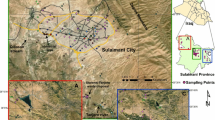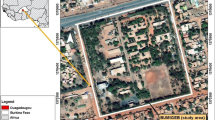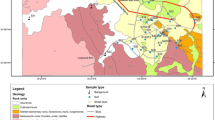Abstract
The increasing population in urban areas in the last decades requires an effort to understand the geochemistry of contaminant elements in urban soil. Topsoil plays a crucial role in the exposure of Potentially Toxic Elements (PTEs) to humans through ingestion, dermal contact, and inhalation. In Chile, the last census revealed that 88.6% of people live in cities or towns and only 11.4% in rural areas. This study presents the first systematic geochemical survey of urban soil in the city of Valdivia, in the South of Chile. Topsoil samples (0–10 cm depth) were collected in less disturbed locations within the city at 130 sampling sites using a grid of 0.25 km2 squares covering a total area of approximately 30 km2. The concentrations of Al, Fe, Na, Ca, Mg, K, Ti, Be, V, Cr, Mn, Co, Ni, Cu, Zn, As, Mo, Sn, Cd, Se, Pb and Hg were measured. The results showed that high concentrations of Cu, V, Zn and Pb are located mainly in the city’s northern area and exceed international soil quality legislation for agricultural use. Data processing comprised plotting of individual spatial distribution maps and the use of a combination of multivariate statistical methods. Hierarchical cluster analysis and principal component analysis identified three element associations. The two element groups V–Al–Ti–Fe–Cr–Co–Mn–Be–Ni and Ca–Na–K–As–Mg are interpreted as a dominant lithological origin related to the most pristine soil conditions in less populated areas. By contrast, the Sn–Pb–Zn–Mo–(Cu–Hg) association presents a significant correlation with urbanization indicators, including vehicular traffic and industrial activities developed since the end of the nineteenth century in Valdivia.









Similar content being viewed by others
References
Adamiec, E., Jarosz-Krzemin´ska, E., & Wieszała, R. (2016). Heavy metals from non-exhaust vehicle emissions in urban and motorway road dusts. Environmental Monitoring and Assessment, 188, 369. https://doi.org/10.1007/s10661-016-5377-1
Agency for Toxic Substances and Disease Registry (ATSDR). (2011). Division of Toxicology and Environmental Medicine. United States Department of Health and Human Service of EEUU. Public Health Service, p 269.
Agency U.E.P. (1986). Guidelines for the health risk assessment of chemical mixtures. Federal Register, 51, 34014–34025.
Almonacid, F. (1995). Valdivia 1870–1935: Imágenes e historias. Universidad Austral de Chile.
Arenas, M., Milovic, J., Pérez, Y., Troncoso, R., Behlau, J., Hanisch, J. & Helms, F. (2005). Geología para el ordenamiento territorial: área de Valdivia, Región de Los Lagos. Servicio Nacional de Geología y Minería, Carta Geológica de Chile, Serie Geología Ambiental 8: 71p., 6 mapas escala 1:100.000 y 1 mapa escala 1:25.000.
Argyrak, A., & Kelepertzis, E. (2014). Urban soil geochemistry in Athens, Greece: The importance of local geology in controlling the distribution of potentially harmful trace elements. Science of the Total Environment, 482–483(2014), 366–377.
Aruta, A., Albanense, S., Daniele, L., Cannatelli, C., Buscher, J. T., De Vivo, B., Petrik, A., Cicchella, D., & Lima, A. (2022). A new approach to assess the degree of contamination and determine sources and risks related to PTEs in an urban environment: the case study of Santiago (Chile). Environmental Geochemistry and Health. https://doi.org/10.1007/s10653-021-01185-6
Baessolo, J., & Fuentes, E. (2011). Cronología y catastro de industrias en Valdivia, una mirada a nuestro pasado industrial. El legado alemán y su influencia en la industria. Valdivia conecta. [En línea]. [Consultado 22 de agosto 2022], Disponible en http://valdivia-conecta.blogspot.com
Barozzi, R., Lemke, R. (1966). El suelo de fundación de Valdivia. Instituto de Investigaciones Geológicas, Estudios Geotécnicos, N°1,1 mapa escala 1:7.500.
Binner, H., Sullivan, T., Jansen, M. A. K., & McNamara, M. E. (2023). Metals in urban soils of Europe: A systematic review. Science of the Total Environment, 854, 158734.
Birke, M., & Rauch, U. (2000). Urban geochemistry: Investigations in the Berlin metropolitan area. Environmental Geochemistry and Health, 22, 233–248. https://doi.org/10.1023/A:1026554308673
Borsdorf, A. (2000). El desarrollo urbano de valdivia: Estudio de caso en una ciudad mediana. Innsbruck, Austria: Instituto De Geografía De La Universidad De Innsbruck. Espacio y Desarrollo, 2000(12), 45–81.
Burt, R., Wilson, M. A., Mays, M. D., & Lee, C. W. (2003). Major and trace elements of selected Pedons in the USA. Journal of Environmental Quality, 32, 2109–2121.
Casanova, M., Salazar, O., Seguel, O., & Luzio, W. (2013). The soils of Chile. World Soils Book Series. https://doi.org/10.1007/978-94-007-5949-7
Cetin, M., Sevik, H., Koc, I., & Zeren Cetin, I. (2023). The change in biocomfort zones in the area of Muğla province in near future due to the global climate change scenarios. Journal of Thermal Biology, 112, 103434. https://doi.org/10.1016/j.jtherbio.2022.103434
CONAF. (2016). Plan de protección contra incendios forestales comuna de Valdivia – Región de 1007/s10653-021-01185-6los Ríos
Core, D. P., Kesler, S. E., Essene, E. J., Dufresne, E. B., Clarke, R., Arms, D. A., & Rivers, M. L. (2005). Copper and zinc in silicate and oxide minerals in igneous rocks from the Bingham: Park City Belt, Utah. The Canadian Mineralogist, 43(5), 1781–1796. https://doi.org/10.2113/gscanmin.43.5.1781
Dao, L., Morrison, L., & Zhang, C. (2010). Spatial variation of urban soil geochemistry in a roadside sports ground in Galway, Ireland. Science of the Total Environment, 408(2010), 1076–1084.
Delmelle, P. (2015). The encyclopedia of volcanoes, volcanic soils. pp. 1253–1264. https://doi.org/10.1016/B978-0-12-385938-9.00072-9
Demetriades, A., Johnson, C.C. & Birke, M. (Editors) (2018). Urban geochemical mapping: The EuroGeoSurveys geochemistry expert group’s URGE project. Special Issue, Journal of Geochemical Exploration, 187, 213 pp. https://doi.org/10.1016/j.gexplo.2017.10.024.Duchaufour, Ph. (1987). Manual de Edafología. Ed. Masson. Barcelona. pp. 214.
Demetriades, A., & Birke, M. (2015a). Urban topsoil geochemical mapping manual (URGE II) (p. 52). EuroGeoSurveys. https://doi.org/10.5281/zenodo.7319866
Demetriades, A., & Birke, M. (2015b). Urban geochemical mapping manual: sampling, sample preparation, laboratory analysis, quality control check, Statistical processing and map plotting (p. 162). EuroGeoSurveys. https://doi.org/10.5281/zenodo.7319969
Dhaliwal, S. S., Naresh, R. K., Mandal, A., Singh, R., & Dhaliwal, M. K. (2019). Dynamics and transformations of micronutrients in agricultural soils as influenced by organic matter build-up: A review. Environmental and Sustainability Indicators, 1–2, 100007. https://doi.org/10.1016/j.indic.2019.100007
Diami, S. M., Kusin, F. M., & Madzin, Z. (2016). Potential ecological and human health risks of heavy metals in surface soils associated with iron ore mining in Pahang, Malaysia. Environmental Science and Pollution Research, 23, 21086–21097. https://doi.org/10.1007/s11356-016-7314-9
El-Zeiny, A. M., & Abd El-Hamid, H. T. (2022). Environmental and human risk assessment of heavy metals at northern Nile Delta regionusing geostatistical analysis. The Egyptian Journal of Remote Sensing and Space Science, 25, 21–35. https://doi.org/10.1016/j.ejrs.2021.12.005
Espinoza, D., & Zumelzu, A. (2016). Valdivia y su evolución post-terremoto 1960: enfoques, factores escalares y condicionantes. Revista Urbana, 33, 14–29.
Feuker, P., V, R. T., Páez, D., Pérez, Y. (2014). Hidrogeología de la cuenca del río Valdivia, Regiones de Los Ríos y de la Araucanía. Servicio Nacional de Geología y Minería. Carta Geológica de Chile, Serie Geología Hidrogeología.
Filippelli, G. M., Morrison, D., & Cicchella, D. (2012). Urban geochemistry and human health. Elements, 8, 439–444.
Hyun Won, J., Young Park, J., & Gyu, L. T. (2007). Mercury emissions from automobiles using gasoline, diesel, and LPG. Atmospheric Environment, 41(35), 7547–7552. https://doi.org/10.1016/j.atmosenv.2007.05.043
Johnson, C. C., Demetriades, A., Locutura, J., & Ottesen, R. T. (Eds.). (2011). Mapping the chemical environment of urban areas (p. 616). Wiley-Blackwell, John Wiley & Sons Ltd. https://doi.org/10.1002/9780470670071
Juárez, I., Enguita, P., Cortez, F., Montaner, D., Barrera, J. & Sanhueza, J. F. (2012). Estudio cuencas principales región de los ríos.
Kamunda, C., Mathuthu, M., & Madhuku, M. (2016). Health risk assessment of heavy metals in soils from Witwatersrand gold mining basin, South Africa. International Journal of Environmental Research and Public Health, 13(7), 663. https://doi.org/10.3390/ijerph13070663
Konstantinovaa, E., Minkinab, T., Sushkovab, S., Konstantinovc, A., Rajputb, V. D., & Sherstnevb, A. (2019). Urban soil geochemistry of an intensively developing Siberian city: A case study of Tyumen, Russia. Journal of Environmental Management, 239(2019), 366–375.
Kumari N. & Mohan C. (2021). Chapter (2): Basics of clay minerals and their characteristic properties. In: Clay and clay minerals. Intech-Open, London, pp. 1–29. https://doi.org/10.5772/intechopen.97672.
Lacassie, J.P., Astudillo, F., Mardones, R., Oliva, P., Castro, R., Quitral, V. & Plaza, F. (2022). Geoquímica y mineralogía de sedimentos fluviales de la cuenca del río Valdivia, regiones de La Araucanía y de Los Ríos, Chile. Servicio Nacional de Geología y Minería, Informe Registrado IR-22–102 (Inédito): 87 p., 5 anexos. Santiago.
Li, J., Wang, G., Liu, F., Cui, L., & Jiao, Y. (2020). Source apportionment and ecological-health risks assessment of heavy metals in topsoil near a factory, central China. Exposure and Health. https://doi.org/10.1007/s12403-020-00363-8
Luebert, L., & Pliscoff, P. (2006). Sinopsis bioclimática y vegetacional de Chile (p. 316). Editorial Universitaria.
Mella, M., Duhart, P., McDonough, M., Antinao, J., Elgueta, S., & Crignola, P. (2012). Geología del área Valdivia-Corral, Región de Los Ríos. Servicio Nacional De Geología y Minería. Serie Geología Básica No 137. Mapa Escala, 1, 100.000.
Montaldo, P. (1983). Características climáticas de la ciudad de Valdivia y alrededores. Revista Agro Sur, 11(2), 138–139.
Instituto Nacional de Estadísticas (INE). 2018. Censo 2017.
Nag, R., O’Rourke, S. M., & Cummins, E. (2022). Risk factors and assessment strategies for the evaluation of human or environmental risk from metal(loid)s: A focus on Ireland. Science of the Total Environment, 802, 149839. https://doi.org/10.1016/j.scitotenv.2021.149
Nanzyo, M., Kanno, H. (2018). Non-crystalline inorganic constituents of soil. In Inorganic constituents in soil. Springer, https://doi.org/10.1007/978-981-13-1214-4_4.
Praveena, S. M., Ismail, S. N. S., & Aris, A. Z. (2015). Health risk assessment of heavy metal exposure in urban soil from Seri Kembangan (Malaysia). Arabian Journal of Geosciences, 8, 9753–9761. https://doi.org/10.1007/s12517-015-1895-3
Qing, X., Yutong, Z., & Shenggao, L. (2015). Assessment of heavy metal pollution and human health risk in urban soils of steel industrial city (Anshan), Liaoning, Northeast China. Ecotoxicology and Environmental Safety, 120, 377–385. https://doi.org/10.1016/j.ecoenv.2015.06.019
Reyes, A., Thiombane, M., Panico, A., Daniele, L., Lima, A., Di Bonito, M., & De Vivo, B. (2019). Source patterns of potentially toxic elements (PTEs) and mining activity contamination level in soils of Taltal city (northern Chile). Environmental Geochemistry and Health. https://doi.org/10.1007/s10653-019-00404-5
Smedley, P., & Kinniburgh, D. (2002). A review of the source, behaviour and distribution of arsenic in natural waters. Applied Geochemistry, 17, 517–568.
Stančić, Z., Fiket, Ž, & Vuger, A. (2022). Tin and Antimony as soil pollutants along railway lines: A Case study from north-western Croatia. Environments, 9, 10. https://doi.org/10.3390/environments9010010
Takeda, A., Kimura, K., & Yamasaki, S. (2004). Analysis of 57 elements in Japanese soils, with special reference to soil group and agricultural use. Geoderma, 119(3–4), 291–307. https://doi.org/10.1016/j.geoderma.2003.08.006
Thornton, I. (1990). Soil contamination in urban areas. Palaeogeography, Palaeoclimatology, Palaeoecology (global and Planetary Change Section), 82(1990), 121–140.
Tume, P., González, E., King, R., Monsalve, V., Roca, N., & Bech, J. (2018). Spatial distribution of potentially harmful elements in urban soils, city of Talcahuano. Chile. Journal of Geochemical Exploration, 184(2018), 333–344.
Tume, P., González, E., Reyes, F., Fuentes, J. P., Roca, N., Bech, J., & Medina, G. (2019). Sources analysis and health risk assessment of trace elements in urban soils of Hualpen, Chile. CATENA, 175, 304–316.
Tume, P., Roca, N., Rubio, R., King, R., & Bech, J. (2016). An assessment of the potentially hazardous element contamination in urban soils of Arica. Chile. Journal of Geochemical Exploration. https://doi.org/10.1016/j.gexplo.2016.09.011
Tume, P., Acevedo, V., Roca, N., Ferraro, F. X., & Bech, J. (2021). Potentially toxic elements concentrations in schoolyard soils in the city of Coronel, Chile. Environmental Geochemistry and Health. https://doi.org/10.1007/s10653-021-00909-y
United States Environmental Protection Agency (USEPA). (1986). Quality criteria for water. United States Environmental Protection Agency office of Water Regulations and Standards. DC, 20460.
United States Environmental Protection Agency (USEPA). (1989). Risk assessment guidance for superfund volume 1: Human health evaluation manual (Part A); Office of Emergency and Remedial Response.
United States Environmental Protection Agency (U.S. EPA). (1996). Soil screening guidance: Technical background document. Superfund |US EPA
United States Environmental Protection Agency (U.S. EPA). (2001). Toxics release inventory: public data release report. Retrieved June 25, 2023, from www.epa.gov/tri/tridata/tri01.
United States Environmental Protection Agency (U.S. EPA). (2023). Regional Screening Levels (RSLs): Generic tables: Resident soil. Retrieved June 24, 2023, from https://www.epa.gov/risk/regional-screening-levels-rsls-generic-tables.
United Nations, Department of Economic and Social Affairs, Population Division. (2019). World urbanization prospects: The 2018 revision (ST/ESA/SER.A/420). United Nations.
United States Environmental Protection Agency (USEPA). (2004). Risk assessment guidance for superfund volume I: Human health evaluation manual (Part E, supplemental guidance for dermal risk assessment). USEPA.
Valdés Durán, A., Aliaga, G., Ceckart, C., Karas, C., Dante, C., & Nario, A. (2021). The environmental geochemical baseline, background and sources of metal and metalloids present in urban, periurban and rural soils in the O’Higgins region, Chile. Environmental Geochemistry and Health. https://doi.org/10.1007/s10653-021-01098-4
Wei, X., Gao, B., Wang, P., Zhou, H., & Lu, J. (2015). Pollution characteristics and health risk assessment of heavy metals in street dusts from different functional reasons Beijing, China. Ecotoxicology and Environmental Safety, 112, 186–192.
Wong, C. S. C., Li, X., & Thornton, I. (2006). Urban environmental geochemistry of trace metals. Environmental Pollution, 142(2006), 1–16.
Wong, M. Y., Rathod, S. D., Marino, R., Li, L., Howarth, R. W., Alastuey, A., et al. (2021). Anthropogenic perturbations to the atmospheric molybdenum cycle. Global Biogeochemical Cycles, 35, e2020GB006787. https://doi.org/10.1029/2020GB006787
Wu, S., Peng, S., Zhang, X., Wu, D., Luo, W., Zhang, T., Zhou, S., Yang, G., Wan, H., & Wu, L. (2015). Levels and health risk assessments of heavy metals in urban soils in Dongguan, China. Journal of Geochemical Exploration, 148, 71–78. https://doi.org/10.1016/j.gexplo.2014.08.009
Acknowledgements
This paper was partially funded by an academic grant provided by the Universidad Austral de Chile to Daniele Tardani. Additional funding was provided by the projects ANID-Fondecyt #1201219, ANID-Fondecyt #11220777, ANID-Fondecyt #11190864 and ANID-FONDAP #15130015 (CRHIAM). VT thanks to the UFRO Postdoc Grant VRIP20P001. We are grateful to Alecos Demetriades and another anonymous reviewer whose criticisms and suggestions helped to improve this manuscript significantly. The Associate Editor Efstratios Kelepertzis is also thanked for editorial handling.
Author information
Authors and Affiliations
Contributions
DT contributed to conceptualization, resources, funding acquisition, project administration, methodology, validation, investigation, writing—original draft, and supervision; FV contributed to fieldwork, conceptualization, methodology, writing—original draft, investigation, supervision and figures preparation. FÁ-A contributed to conceptualization, writing—review and editing; VT contributed to resources, writing—review and editing. DJ contributed to writing—review and editing. JPL contributed to validation, writing—review and editing. CS contributed to fieldwork and methodology. PS-A contributed to resources, writing—review and editing. LD contributed to validation, writing—review and editing. LG contributed to resources, writing—review and editing.
Corresponding author
Ethics declarations
Conflict of interest
The authors declare no conflict of interest.
Additional information
Publisher's Note
Springer Nature remains neutral with regard to jurisdictional claims in published maps and institutional affiliations.
Supplementary Information
Below is the link to the electronic supplementary material.
Rights and permissions
Springer Nature or its licensor (e.g. a society or other partner) holds exclusive rights to this article under a publishing agreement with the author(s) or other rightsholder(s); author self-archiving of the accepted manuscript version of this article is solely governed by the terms of such publishing agreement and applicable law.
About this article
Cite this article
Tardani, D., Vera, F., Álvarez-Amado, F. et al. Evaluating natural and anthropogenic inputs on the distribution of potentially toxic elements in urban soil of Valdivia, Chile. Environ Geochem Health 45, 7841–7859 (2023). https://doi.org/10.1007/s10653-023-01687-5
Received:
Accepted:
Published:
Issue Date:
DOI: https://doi.org/10.1007/s10653-023-01687-5




